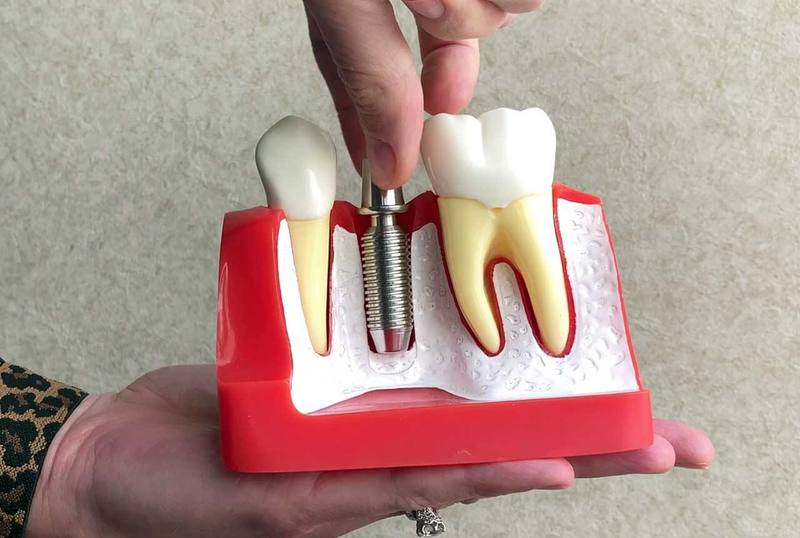
If you’re dealing with a loose dental implant, don’t worry, I’ve got you covered! In this article, we’ll dive into the ins and outs of how to fix a loose dental implant. Whether you’re experiencing discomfort or are concerned about the stability of your implant, we’ll explore the various solutions and steps you can take to address this issue.
Having a loose dental implant can be quite unsettling, but rest assured, there are ways to resolve this problem. We’ll discuss the common causes of a loose implant, such as improper placement or inadequate osseointegration. Then, we’ll delve into the actionable steps you can take to fix it, including visiting your dentist or oral surgeon for a thorough examination and potentially undergoing a corrective procedure. So, without further ado, let’s get started on the journey to restoring the stability and functionality of your dental implant!
If you’re experiencing a loose dental implant, it’s important to seek professional help. Follow these steps for a possible solution:
- Visit your dentist: Schedule an appointment with your dentist to assess the situation.
- X-ray examination: Your dentist may take X-rays to determine the cause of the implant’s looseness.
- Treatment plan: Based on the evaluation, your dentist will recommend a suitable treatment plan.
- Implant stabilization: This may involve tightening the implant, bone grafting, or replacing the implant altogether.
- Follow-up care: After the procedure, follow your dentist’s instructions for proper care and maintenance of the implant.
Remember, professional guidance is crucial in resolving a loose dental implant.

How to Fix Loose Dental Implant?
Dental implants are a popular and effective solution for replacing missing teeth. However, over time, it is possible for a dental implant to become loose or unstable. This can be a cause for concern, as it can affect the functionality and aesthetics of your smile. In this article, we will explore the various reasons why a dental implant may become loose and discuss the steps you can take to fix the issue.
Common Causes of Loose Dental Implants
1. Peri-implantitis:
- Explanation: Inflammation of tissues surrounding the implant.
- Contributing Factors: Poor oral hygiene, smoking, or a history of gum disease.
2. Improper Placement:
- Explanation: If the implant wasn’t correctly positioned or integrated during the initial procedure.
- Potential Issues: May lead to gradual loosening over time.
3. Excessive Force or Trauma:
- Explanation: Occurs due to biting on hard objects, facial injuries, or bruxism (teeth grinding).
- Impact: Puts undue pressure on the implant, causing it to become loose.
Treating Loose Dental Implants
1. Professional Evaluation:
- Action: Seek prompt dental care if you suspect a loose implant.
- Procedure: Dentist assesses the implant and prescribes an appropriate solution based on the cause and severity.
2. Adjustment and Stabilization:
- Treatment: Tightening the implant through abutment or crown adjustments.
- Purpose: Stabilizes the implant and prevents further movement.
3. Bone Grafting:
- When Needed: In cases requiring additional support.
- Procedure: Involves bone grafts from another part of the body or synthetic materials to strengthen the area around the implant.
4. Implant Removal:
- Scenario: Severe looseness or non-viability.
- Procedure: Careful extraction, evaluation of surrounding bone and tissue, followed by potential placement of a new implant.
Preventing Loose Dental Implants
1. Oral Hygiene Maintenance:
- Key Actions: Brushing twice a day, daily flossing, regular dental check-ups, and cleanings.
- Purpose: Prevents infection and inflammation around the implant.
2. Bruxism Management:
- Recommendation: Nightguard usage if there’s a history of teeth grinding.
- Objective: Protects both natural teeth and dental implants from excessive force.
3. Avoiding Damaging Habits:
- Advice: Refrain from chewing on hard objects or using teeth as tools.
- Outcome: Reduces the risk of damage to the implant.
In conclusion, a loose dental implant can be a cause for concern, but with prompt dental care and proper treatment, it can be fixed. By understanding the common causes of loose implants and taking preventive measures, you can help maintain the stability and longevity of your dental implant. Remember to consult with your dentist if you suspect any issues with your dental implant to ensure appropriate treatment and care.
Key Takeaways: How to Fix a Loose Dental Implant
- Loose dental implants can cause discomfort and affect your oral health.
- Contact your dentist immediately if you notice a loose dental implant.
- Depending on the situation, your dentist may tighten the implant or recommend a replacement.
- Proper oral hygiene and regular dental check-ups can prevent implant loosening.
- Follow your dentist’s instructions for post-implant care to ensure long-term stability.
Frequently Asked Questions
Question 1: What are the common causes of a loose dental implant?
A loose dental implant can be caused by several factors. One common cause is poor oral hygiene. If you don’t properly care for your implant by brushing and flossing regularly, it can lead to a buildup of plaque and bacteria, which can weaken the implant’s stability. Another cause can be excessive biting or grinding of the teeth, which puts unnecessary pressure on the implant and can loosen it over time. Additionally, if the implant was not properly placed or if there was an issue with the healing process, it can result in a loose implant.
To prevent a loose dental implant, it’s important to maintain good oral hygiene, wear a nightguard if you grind your teeth, and follow your dentist’s post-operative instructions after implant surgery.
Question 2: Can a loose dental implant be fixed?
Yes, a loose dental implant can often be fixed. The first step is to visit your dentist as soon as you notice any signs of a loose implant. They will assess the situation and determine the best course of action. In some cases, a simple tightening of the implant screw may be all that’s needed to secure the implant back in place. However, if there is significant damage or instability, additional treatment may be required.
Depending on the severity of the situation, your dentist may recommend a bone graft to strengthen the surrounding bone, or they may suggest removing the implant and replacing it with a new one. It’s important to address a loose dental implant promptly to prevent further complications and maintain the integrity of your smile.
Question 3: How long does it take to fix a loose dental implant?
The duration of fixing a loose dental implant depends on the specific case and the treatment plan recommended by your dentist. In some instances, a simple tightening of the implant screw can be done in a single visit, which typically takes around 30 minutes to an hour. However, if more extensive treatment is required, such as a bone graft or implant replacement, the process may take several months.
During this time, your dentist will monitor your progress and ensure that the implant is properly healing and integrating with the surrounding bone. It’s important to follow your dentist’s instructions and attend all scheduled appointments to ensure the best possible outcome.
Question 4: Are there any risks associated with fixing a loose dental implant?
Fixing a loose dental implant does come with some risks, although they are relatively rare. The most common risk is infection, which can occur during any surgical procedure. Your dentist will take precautions to minimize the risk of infection, such as sterilizing instruments and providing post-operative care instructions.
In some cases, there may be a risk of damage to the surrounding teeth or bone during the repair process. However, with proper planning and expertise, these risks can be minimized. It’s important to choose an experienced and qualified dentist to perform the necessary repairs to ensure the best possible outcome.
Question 5: How can I prevent a dental implant from becoming loose?
Preventing a dental implant from becoming loose starts with good oral hygiene practices. Brush your teeth at least twice a day and floss daily to remove plaque and bacteria that can weaken the implant’s stability. Use an antibacterial mouthwash to further reduce the risk of infection.
If you grind your teeth, wearing a nightguard can help protect your implant from excessive pressure. Avoid biting down on hard objects or using your teeth as tools, as this can also put unnecessary stress on the implant. Lastly, be sure to visit your dentist regularly for check-ups and cleanings, as they can monitor the health of your implant and address any potential issues before they become more serious.
Final Summary: How to Fix Loose Dental Implant?
This comprehensive guide addresses fixing a loose dental implant, highlighting causes like poor oral hygiene, bite misalignment, and bone loss. Emphasizing prevention, it urges proper oral care. If faced with a loose implant, scheduling a prompt dentist appointment is crucial. Treatment options range from tightening and replacing parts to potential bone grafting. Timely action prevents complications like bone loss and infection. Each case is unique, requiring personalized guidance from dental professionals. Regular care and dental visits ensure the longevity of your dental implant. The guide concludes with a positive outlook, emphasizing maintaining a healthy, secure smile.
Call or Book appointment online
:Ace Dental Care Alpharetta office: 678-562-1555 - Book Now
Ace Dental Care Norcross office: 770-806-1255 - Book Now
Disclaimer
This blog post was generated by artificial intelligence. The content of this post may not be accurate or complete, and should not be relied upon as a substitute for professional advice. If you have any questions about the content of this post, please contact us.
We are constantly working to improve the accuracy and quality of our AI-generated content. However, there may still be errors or inaccuracies. We apologize for any inconvenience this may cause.





